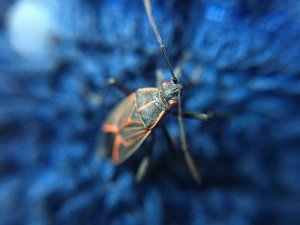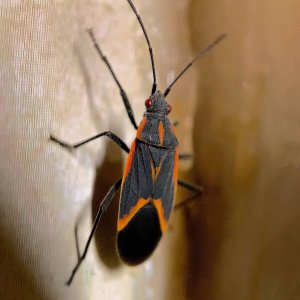Boxelder Bugs are a nuisance rather than a problem.
While these two words may not seem that different, when it comes down to these specific insects, the pest-control and pest-management specialists at Pestco know full well that there is a definitely a distinction.
These bugs don’t sting, transmit disease or cause harm or significant property damage to homes or plants.
They are related to stinkbugs cluster flies, lady bugs and cicadas and named after their primary food source, which is the box elder tree.
For the most part, they are known to feed off the feminine counterpart of these trees, which produce both sap and seed pods and other maple and ash tree species.
Box elders are a species known as “ash-leaved maples.”
They differ from other maple trees because they aren’t sold commercially and are more like weeds because they grow so rapidly and can reach a height of up to 60 feet.
The female trees, which are distinguished from the males by their colorful blooms, attract box elder bugs much more than the males because its fruit, which resemble small dangling pods that turn green when pollinated, are irresistible to these insects.

What Do Boxelder Bugs Look Like?
This bug takes on a different appearance at each of the three stages of its life; namely egg, nymph and adult.
They are most often noticed by humans during the adult period of their life cycle when they are about an inch in length.
Long, black wings located close to the head cover the red abdomens found on adult bugs.
The wings expand, cover the torso, and are fully functional. Nymphs are smaller. about one-sixteenth of an inch long and almost completely red with exposed torsos.
They are oval in shape with six legs and two antennae that extend from their small heads. Boxelder eggs, which are found on trees in the spring, are very small and reddish in color.
Behavior And Habitat
These insects thrive during the spring and summer, feeding off the leaves, flowers and seeds of the box elder trees, which grow in wild profusion naturally.
They are well-equipped for the process with mouth parts that can easily pierce the tree bark, which in turn provides an avenue for them to reach the sap.
They also eat seed pods from the female box elder tree. They lay their eggs near their food sources; namely on the trunks, bark and leaves.
As a general rule of thumb, the more you see boxelders during summer, the more likely it is that they will attempt to overwinter near your home in the cooler months of the year.
In order to energize and warm themselves up, box elder bugs seek out sunny, heat reflecting surfaces like windows, sky lights, concrete and homes with western or southern exposures.

According to Eric Benson, Ph.D., a Clemson University professor of entomology: “The life cycle and activity of boxelder bugs is closely tied to seed production and new leaf growth on boxelder and maple trees in the spring… they typically move into structures during fall when temperatures start to drop…In the fall, they become gregarious and will fly and congregate often on the sunny side of structures, and look for cracks and crevices to get into shelter areas for the winter.”
Box elder bugs seek refuge from the cold, harsh winter in wall voids and attics.
The pest-control and pest-maintenance specialists at Pestco are often called to a home to control an infestation in the spring and summer months when these insects re-emerge in large numbers.
While they do not bite, cause extreme damage to plants or structures and they do not reproduce indoors, these bugs can deface and badly stain home interiors (mostly carpets and fabrics), and exteriors with their red excrement, which emits a nasty smell.
Orchards that need their fruits to look as good as they taste do suffer financially from the fruit and leaf malformations these insects cause to the plants that they feed upon.
Do Boxelder Bugs Have Their Place In Nature?
Although some of the world’s nastiest insects do have a place in the natural order of things, somehow box elder bugs missed that train.
They are not pollinators or a food source for other insects or animals within the food chain, and their presence is often disruptive to the lives of nearby pollinators and other eco-helpful insects.
Perhaps they have no purpose within the eco-system themselves, but the trees they feed upon do bolster the survival of a wide variety of wildlife that rely on their fruits and leaves that continue to flourish in late summer and early fall when food sources become scarce.
How To Deal With A Boxelder Bug Infestation
It is vitally important to address a boxelder bug infestation as soon as its is noticed.
Once they gain ingress to the walls of a home, they are difficult to eliminate and dealing with them is not and never will be a do it yourself project.
Without the guidance of the pest-control and pest-maintenance specialists at Pestco, such actions can only intensify an infestation.

Crushing these bugs is a mistake because it not only increases the staining but also the foul smelling liquid with pheromones that they release when threatened, which attracts other box elders bugs.
Until professional help arrives, vacuum them up, throw them out in a sealed plastic bag and place in outdoor trash bin.
For best results, it is important to use either a soft brush attachment or an open suction hose option.
Carefully wipe down surfaces where the bugs congregate with soapy water, as this will remove the pheromones they secrete.
5 Key Preventive And Pro Active Measures
It must be said that it is much more difficult to predict which years will produce high numbers of boxelder bugs than with other insects because they are not known to necessarily return to a place where they might have been a year before.
Nevertheless, our pest-control and pest-maintenance specialists at Pestco suggest the following tips to help prevent a box elder infestation.
1. Tend To Your Lawn Frequently
Mowing the lawn frequently will pick up those seeds from the tree that comprise the big elder bug’s food source. Removing plants and debris from the edges of your lawn helps to eliminates their hiding places.
2. Seal Cracks On Your Property
To prepare for the cooler months of the year, search out areas where these bugs congregate. If you find any cracks or gaps, seal them off with weather-proofing or caulk. Areas of concern include: doors; ceiling lights; dryer vents, fittings in or around siding and outdoor faucets.
3. Repair Screens And Install Door Sweeps If They Open To The Outdoors
4. Clean Large Heat Reflective Surfaces With Dish Soap
This is an important measure because once they congregate on the exterior of a building, they can often find ingress. Spray or scrub down their perches with soapy water or scented cleaning solutions.
5. Trim Box Elder Trees
This will limit that amount of seeds that will drop to the ground and provide nourishment for these bugs.
Don’t Ignore A Boxelder Bug Infestation!
If you live or operate a business anywhere throughout the Greater Pittsburgh area and are experiencing a Boxelder Bug or any other type of pest infestation, our teams at Pestco Professional Services are always there to help! Give them a call them today!
 Over 300 Reviews
Over 300 Reviews 